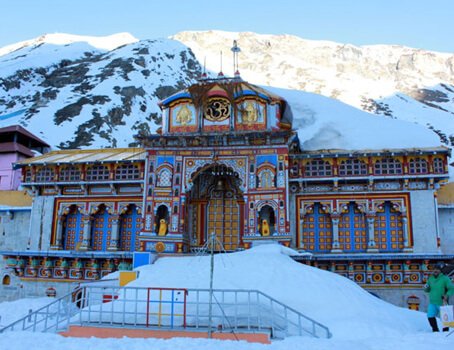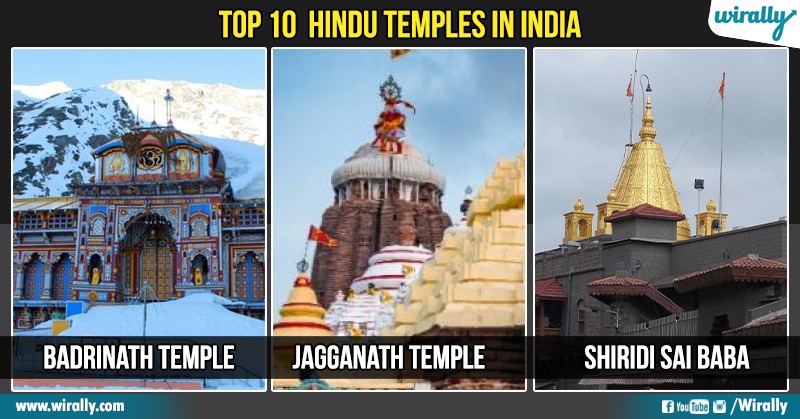TOP 10 HINDU TEMPLES IN INDIA
Hindu temples serve as places of worship for those who practise this ancient faith. Hindu temples may be found all across India, and the range of architectural styles that they feature reflects the country’s many regions and cultural traditions.
The sanctum sanctorum, sometimes referred to as the garbhagriha, is the centre of any Hindu temple and is where the primary deity or deities are kept. Depending on the tradition and significance of the temple, there may be one or many shrines.
Intricate carvings and sculptures that reflect themes from Hindu mythology as well as the lives of saints and deities are frequently used to decorate Hindu temples. They are renowned for their complex designs and vivid hues as well.
1. Badrinath Temple
Badrinath Temple is one of the most significant pilgrimage destinations in India, and it is dedicated to Lord Vishnu. It is one of the four famous holy places known as “Char Dham” by Hindus.
To reach this sacred sanctuary, pilgrims must make a difficult trek across the massive mountains. The Badrinath Temple is designed to resemble a cone with a spire and a tiny dome topped with a gilded bull. Although there are various tales that date them back to the Vedic era, the general consensus is that Guru Adi Shankaracharya founded them in the ninth century.

2. Shri Puri Jagannath Temple
Jagannath Puri Temple is a sacred temple devoted to Lord Jagannath, his sister Devi Subhadra, and his brothers, Lord Balabhadra and Lord Balabhadra. Hindus believe that Lord Jagannath is a manifestation of Lord Vishnu.
One of the four Char Dham pilgrimage sites for the Hindu community is the Jagannath Temple. Jagannath is regarded as a non-sectarian god because of the depictions of Lord Jagannath in several religions (Hinduism, Buddhism, and Jainism). The Ratha Yatra, an annual celebration held at the temple, is quite lovely. In the eastern states of India, it is observed every June/July.The three gods are fervently carried out of the Garbhagriha of the main temple and placed in a chariot before being transported there by several volunteers.
3. Shiridi sai baba Temple
Shirdi Sai Baba Temple, one of the oldest and most renowned places of worship, commemorates the teachings and life of Saint Sai Baba, known locally as “Sai” by his devotees. The temple is situated 270 km from Mumbai in Shirdi, a small town in Ahmednagar, Maharashtra. The holy shrine, which is around 200 square metres in area, is one of the most popular destinations for pilgrims from all over the world.
(adsbygoogle = window.adsbygoogle || []).push({});
4. Shri Kashi Vishwanath Temple
The famous Hindu temple for Lord Shiva is the Kashi Vishwanath Temple. It is located in Varanasi, Uttar Pradesh, in India’s Vishwanath Gali. One of the twelve Jyotirlingas, the holiest of Shiva temples, is located on the western bank of the sacred Ganges. The main god is known by the names Shri Vishwanath and Vishweshwara, which literally mean “Lord of the Universe” (IAST: Vishveshvara or Vishveshvur). Varanasi was named Kashi (“shining”) in ancient times, and so the temple is often called Kashi Vishwanath Temple.
(adsbygoogle = window.adsbygoogle || []).push({});
5. Vaishno Devi Temple
Inside the Indian Union area of Jammu and Kashmir, near Katra in the Trikuta Mountains, lies the Vaishno Devi Temple, a significant Hindu shrine devoted to Vaishno Devi. One of the 108 Shakti Peethas honouring Durga, also known as Vaishno Devi, is the temple. One of the most popular pilgrimage destinations in India is this one. Millions of people visit the temple each year. Even one crore people attend festivities like Navaratri, according to the statistics. One of India’s wealthiest temples is Vaishno Devi. As per authors Michael Barnett and Janice Gross Stein, the Mata Vaishno Devi Shrine in Jammu receives over $16 billion in annual revenue, primarily from contributions from followers.
For all Hindus, the temple is a holy place. Several well-known saints, like Vivekananda, have visited this temple.
(adsbygoogle = window.adsbygoogle || []).push({});
6. Tirumala Tirupati Temple
In the Indian state of Andhra Pradesh’s Tirupati district, in the hill town of Tirumala, is the Sri Venkateswara Swami Vaari Temple, a Hindu temple. The temple is devoted to Venkateswara, a manifestation of Vishnu who is said to have come to earth to rescue humanity from the hardships and tribulations of the Kali Yuga. As a result, the location has been given the name Kaliyuga Vaikuntha, and the local god is known as Kaliyuga Prathyaksha Daivam. Tirumala Temple, Tirupati Temple, and Tirupati Balaji Temple are some of the various names for the shrine. Other names for Venkateswara include Balaji, Govinda, and Srinivasa.
7. Sree Padmanabhaswamy Temple
In Thiruvananthapuram, the state capital of Kerala, India, is an ancient Hindu temple known as the Shree Padmanabhaswamy Temple. The name of the city, Thiruvananthapuram, means “The City of Lord Ananta” in the Malayalam and Tamil languages (Ananta being a form of Vishnu). With its tall walls, 16th-century gopura, and exquisite synthesis of the Chera and Dravidian architectural styles, the temple is situated in southern India. The Adikesava Perumal temple at Thiruvattar, in the Kanyakumari district of Tamil Nadu, is somewhat modelled after the Ananthapura temple in Kumbla, in the Kasaragod region of Kerala, which some traditions claim to be the original spiritual residence of the deity (Moolasthanam).
The main god is Padmanabhaswamy (Vishnu), who is worshipped while lying on the endless snake Adi Shesha in the “Anantha Shayana” pose, or eternal yogic sleep. The Travancore royal family’s tutelary god is Padmanabhaswamy. The current trustee of the temple is Moolam Thirunal Rama Varma, the titular Maharaja of Travancore.
(adsbygoogle = window.adsbygoogle || []).push({});
8. Amarnath Cave Temple
About 29 kilometres from Pahalgam, at an elevation of 3,888 metres, is the holy temple known as Amarnath Ji, or Amarnath Temple. A Shiva Lingam, a phallus-shaped creation formed of ice that Hindus throughout the world regard as the most sacred emblem, is located inside the cave. Devotees go in great numbers there from June to August on the Amarnath Yatra, a well-known pilgrimage that starts in Chandanwari. One of the 18 Maha Shakti Peethas, or the most sacred sanctuaries in Hinduism, is thought to be located there. The Amarnath Temple is a place to seek blessings, but its surroundings also provide breathtaking views.
9.Sri Ranganathaswamy Temple
At Srirangam, Tiruchirapalli, Tamil Nadu, there is a Hindu temple called Srirangam Temple dedicated to Sri Ranganathar. One of the most significant temples for Lord Vishnu’s devotion there are several more names for the Srirangam Temple, including Ranganathaswamy Temple, Ranganathar Temple, and Sri Ranganatha Temple. There are several more names for Sri Ranganathar, including Ranganathar, Rangan, Aranganathar, Ranga, and Thenarangathan.
One of the greatest religious complexes in the whole globe, Srirangam Temple, is located within India’s largest temple complex. The Ranganathaswamy Temple was allegedly built during the Vijayanagara era and has Hindu architectural design (1333–1565). The Thenkalai school of Sri Vaishnavism is practised and worshipped in the temple.
(adsbygoogle = window.adsbygoogle || []).push({});
10. Somnath Temple
The Hindu temple known as Somnath, also known as Somantha temple or Deo Patan, is situated near Prabhas Patan, Veraval, in Gujarat, India. It is considered the first of Shiva’s twelve Jyotirlinga temples, making it one of the holiest pilgrimage destinations for Hindus. The initial iteration of the Somnath temple may have been constructed as early as the first millennium BCE or as late as the ninth century AD, according to estimations. Yet, the “Prabhasa-Pattana” (Prabhas Patan) is described as a tirtha (pilgrimage place), where this temple is located, in ancient Hindu literature written in Sanskrit.
written by Varsha

